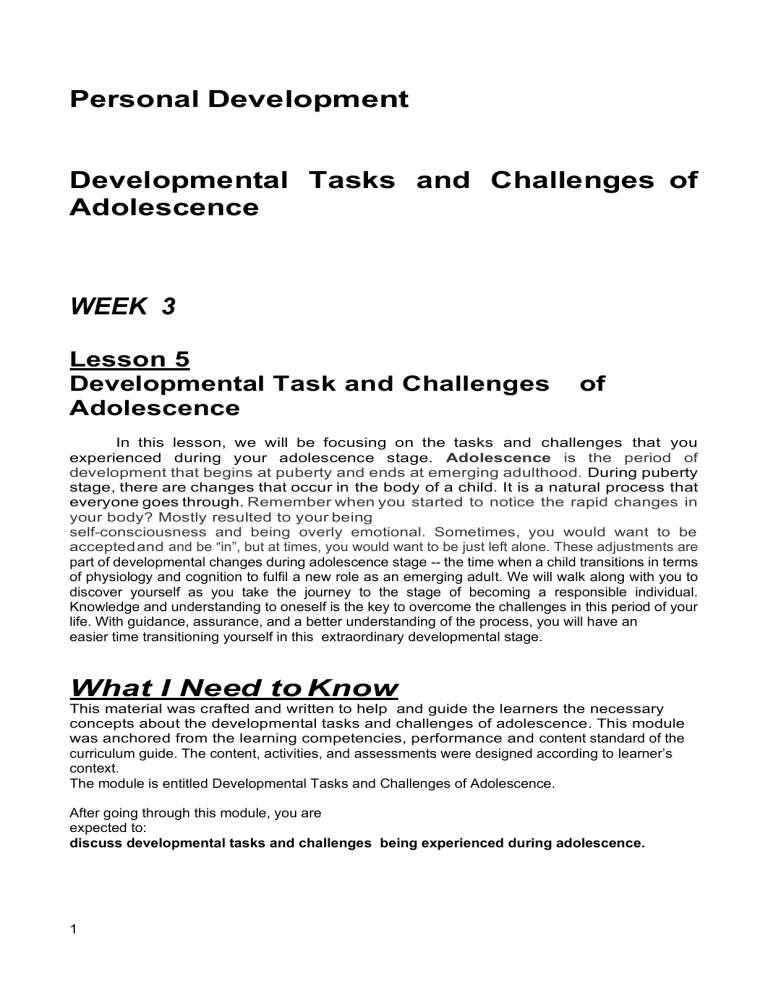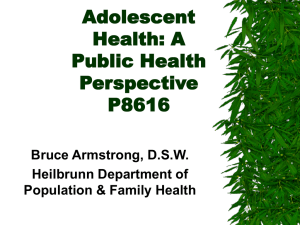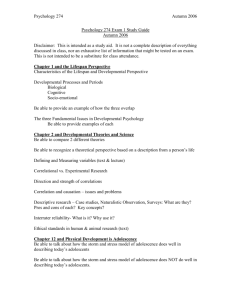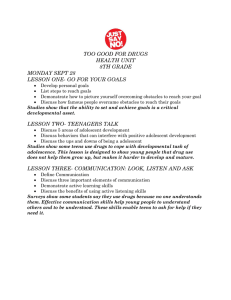
Personal Development Developmental Tasks and Challenges of Adolescence WEEK 3 Lesson 5 Developmental Task and Challenges Adolescence of In this lesson, we will be focusing on the tasks and challenges that you experienced during your adolescence stage. Adolescence is the period of development that begins at puberty and ends at emerging adulthood. During puberty stage, there are changes that occur in the body of a child. It is a natural process that everyone goes through. Remember when you started to notice the rapid changes in your body? Mostly resulted to your being self-consciousness and being overly emotional. Sometimes, you would want to be accepted and and be “in”, but at times, you would want to be just left alone. These adjustments are part of developmental changes during adolescence stage -- the time when a child transitions in terms of physiology and cognition to fulfil a new role as an emerging adult. We will walk along with you to discover yourself as you take the journey to the stage of becoming a responsible individual. Knowledge and understanding to oneself is the key to overcome the challenges in this period of your life. With guidance, assurance, and a better understanding of the process, you will have an easier time transitioning yourself in this extraordinary developmental stage. What I Need to Know This material was crafted and written to help and guide the learners the necessary concepts about the developmental tasks and challenges of adolescence. This module was anchored from the learning competencies, performance and content standard of the curriculum guide. The content, activities, and assessments were designed according to learner’s context. The module is entitled Developmental Tasks and Challenges of Adolescence. After going through this module, you are expected to: discuss developmental tasks and challenges being experienced during adolescence. 1 What’s In In module 4, you learned that life is full of challenges. Nonetheless, what matters is how you manage and overcome the challenges that you encounter in your life. This may be difficult but learning to accept these difficulties may lead you in the right directions. Your thoughts,feelings, and behavior toward a situation reflects yourself as a person. Moreover, dealing with circumstances makes you become a better individual. Read and express your thoughts, feelings, and ideas on the following situations. Situation No. 1 John is an active member of school organizations.He has a lot of talents to share and ideas to contribute to their club. Aside from that, he is known for his good looks, neatness, and tidiness. However, these seemingly likeable characteristics became the very reasons for rumors and gossips-- that he is a member of the LGBTQ+I community. This hurt him so much that he almost wanted to drop from schooling. Give your reaction: Situation No. 2 Erica is a Grade 11 student. Although she is quite plump, she is undeniably pretty. Since she is sociable, she became popular and gained a lot of friends in school. She is just an average student but having a crush on her Top one classmate urged her to spend late nights studying to keep up with him. However, all her efforts still fell short and she did not make it to the cut of students with honors. Because of this, she developed an eating disorder that caused her to lose huge weight. She also started to have breakouts. With these, the then friendly Erica became aloof and self-conscious. Give your reaction. Processing Questions: 1.What kind of adolescent did the two students portray in the two situations? 2.What challenges did John and Erica experience? 3.What challenges do Filipino adolescents face most? 2 What’s New “Who are you?' said the Caterpillar. This was not an encouraging opening for a conversation. Alice replied, rather shyly, `I--I hardly know, sir, just at present-- at least I know who I was when I got up this morning, but I think I must have been changed several times since then.' What do you mean by that?' said the Caterpillar sternly. `Explain yourself!' `I can't explain myself, I'm afraid, sir' said Alice, `because I'm not myself, you see.' `I don't see,' said the Caterpillar. `I'm afraid I can't put it more clearly,' Alice replied very politely, `for I can't understand it myself to begin with; and being so many different sizes in a day is very confusing.' Alice in Wonderland-Lewis Carroll Adolescence is defined as the period between the normal onset of puberty and the beginning of adulthood. In the Oxford English Dictionary, it was derived from; late Middle English (as a noun): via French from Latin adolescent- ‘coming to maturity’, from adolescere, from ad- ‘to’ + alescere ‘grow, grow up’, from alere ‘nourish’. The adjective dates from the late 18th century.” The transition period between childhood and early adulthood is quite difficult. This is the most crucial stage because this is the time when teens start defining themselves. Remember, however, that each adolescent’s experiences, individual changes, and growth vary. ACTIVITY 1 The following illustrations a boy and a girl adolescent. Let one represent you and recall the challenges you have experienced during your adolescence stage. Write your answers inside the box below. 3 What is It Example: rapid changes of physical appearance What is It Processing Questions: 1.What were the most difficult challenges you have encountered? _______________________________________________________________________________ 2.How were you able to overcome these challenges? _______________________________________________________________________________ 3.How did these challenges help you to be a better person? How do you think this would prepare you to your adulthood? _______________________________________________________________________________ Adolescence is a stage in a young person’s life in which they move from dependency on their parents to independence, autonomy, and maturity. The young person begins to move from the family as their major social system to his/her peers as a more appealing social group that might influence his/her adulthood and independence. Undeniably, biological, cognitive, psychological, social, moral, and spiritual changes could be both exciting and daunting for these may affect one’s independence and perspectives in life. Consequently, oftentimes, it is the members of the family who take notice of these changes in patterns and behaviors. Here is the list of the most common challenges that adolescents experience: Biological Challenges Adolescence begins with the first well-defined maturation event called puberty. Included in the biological challenges are the changes that occur due to the release of the sexual hormones that affect emotions. Mood changes can increase which can have an impact on relationships both at home with parents and siblings and peers at school. Cognitive Challenges Piaget, in his Theory of Social Development, believed that adolescence is the time when young people develop cognitively from “concrete operations” to “formal operations”, so they are able to deal with ideas, concepts, and abstract theories. It takes time to develop confidence using these newly acquired skills, and they may make mistakes in judgment. Learning through success and failure is part of the learning process for the adolescent. Adolescents are egocentric. They can become self-conscious thinking they are being watched by others, and at other times they behave as if they were on a center stage and perform for a non-existent audience. For example, acting like a music idol, singing their favorites songs in their room with all the accompanying dance steps. Psychological Challenges The notable psychological challenge that the adolescent must cope with is moving from childhood to adulthood. A new person is emerging, thus, rules will change, and more responsibilities will be placed on him/her, so a certain standard of behavior is now required to be maintained. Accountability is becoming an expectation 4 from both parental and legal concepts. As adolescents continue their journey of self-discovery, they continually adjust to new experiences, even biologically and socially. This can be both stressful and anxiety-provoking. It, therefore, is not surprising that adolescents can have a decreased tolerance for change; hence, it becomes increasingly more difficult for them to modulate their behaviors which are sometimes displayed by inappropriate mood swings and angry outbursts. Health Issues of adolescence: Eating Disorders An eating disorder describe illness that are characterized by irregular eating habits and severe distress or concern about body weight or shape. Eating disturbances may include inadequate or excessive food intake which can ultimately damage an individual’s well-being. The most common forms of eating disorders are the following. Types of Eating Disorders: 1.Anorexia Nervosa Teenagers with anorexia may take extreme measures to avoid eating and to control the quantity and quality of the foods they eat. They may become abnormally thin and still talk about feeling fat. They typically continue to strict diet even at very unhealthy weights because they have a distorted image of their body. 2.Bulimia Nervosa Teenagers with bulimia nervosa typically ‘binge and purge’ by engaging in uncontrollable episodes of overeating (bingeing) usually followed by compensatory behavior such as: purging through vomiting, use of laxatives, enemas, fasting, or excessive exercise. Eating binges may occur as often as several times a day but are most common in the evening and night hours. Mental Health Disorder Anxiety Disorders Anxiety disorders are a group of mental disorders characterized by significant feelings of anxiety and fear. Anxiety is a worry about future events, and fear is a reaction to current events. These feelings may cause physical symptoms, such as a fast heart rate and shakiness. Mood Disorders The development of emotional or behavioral symptoms in response to identifiable stressors that occur within 3 months of the onset of the stressors. Here, low mood, tearfulness, or feelings of hopelessness are predominant. Major Depressive Disorder (MDD): A period of at least 2 weeks during which there is either depressed mood or the loss of interest or pleasure in nearly all activities. In children and adolescents, the mood may be irritable rather than sad. 5 Bipolar Disorder: A period of abnormally and persistently elevated, expansive, or irritable mood and abnormally and persistency increased activity or energy, lasting at least 4 consecutive days and present most of the day, nearly every day, or that requires hospitalization. Attention Deficit Hyperactivity Disorder Definitions of the symptom complex known as attention-deficit/hyperactivity disorder (ADHD) differ, but severe problems with concentration or attention and/or hyperactivity are estimated to affect adolescents. Six times as many boys as girls are affected. School phobia School phobia, also called school refusal, is defined as a persistent and irrational fear of going to school. It must be distinguished from a mere dislike of school that is related to issues such as a new teacher, a difficult examination, the class bully, lack of confidence, or having to undress for a gym class. The phobic adolescent shows an irrational fear of school and may show marked anxiety symptoms when in or near the school. Learning disabilities Learning abilities encompasses disorders that affect the way individuals with normal or above normal intelligence receive, store, organize, retrieve, and use information. Problems included dyslexia and other specific learning problems involving reading, spelling, writing, reasoning, and mathematics. Undiagnosed learning disabilities are a common but manageable cause of young people deciding to leave school at the earliest opportunity. Social Issues Sexual Abuse Sexual abuse is a sexual behavior, or a sexual act forced upon a woman, man, or child without their consent. Sexual abuse includes abuse by another man, woman, or child. Sexual abuse in childhood may result in problems of depression and low selfesteem, as well as in sexual difficulties, either avoidance of sexual contact or, on the other hand, promiscuity or prostitution. Sexual abuse in children is regarded by the World Health Organization (WHO) as one of the major public health problems. Substance Abuse Many communities are plagued with problems of substance abuse among youth. Some children start smoking or chewing tobacco at an early age, aided by easy access to tobacco products. Many of our youth, with limited supervision or few positive alternatives, drink too much beer and liquor. Other youth, influenced by their peers, use other illegal drugs. Our youth suffer from substance abuse in familiar ways: diminished health, compromised school performance, and reduced opportunities for development. Our communities also bear a heavy burden for adolescent substance abuse. 6 Influence of Mass Media Adolescents spend a significant amount of time in viewing and interacting with electronic devices in the form of TV, radio, cellphone, and computers. Mass media activate and reinforce attitude and contribute significantly in the formation of new attitudes and will continue to affect children's cognitive and social development. Impact of Social Media Social media is a constant part of our lives: we are bombarded by alerts from Facebook, Twitter, Snapchat, and Instagram from the time we wake up to the time we go to sleep. This constant noise is associated with negative mental health outcomes in younger generations who have grown up with the chatter. This constant noise is associated with negative mental health outcomes in younger generations who have grown up with the chatter. In an article by Dr. Shamard Charles (2012), he summarized that “recent studies have shown that more social media use is associated with increased reported symptoms of social anxiety, social isolation, and feelings of loneliness.” Another effect of social media is an intense feeling of isolation. It is easy to think that checking on what friends are posting on Facebook will lead to a greater sense of connectedness, but studies have shown that it’s actually the opposite. Developmental Tasks In the eight stages of Psychosocial Developmental Theory of Erik Erikson, Identity vs. Role Confusion (this stage is the age between 12 to 18 years old) explains that adolescents would try to explore and figure out their own identity and try to fit in with social interactions at the same time. According to Erikson, an adolescent’s main task is developing a sense of self. Adolescents struggle with questions “Who am I?” and “What do I want to do with my life?” Most of the adolescents try to explore various roles and ideas and look for a place where they can fit, set goals, and attempt to discover themselves. As an adolescent who is entering the stage of adulthood, you are responsible for your own being. Accepting yourself and ensuring your body’s physical health help you build stronger personality and sense of identity. Likewise, building a strong relationship with your family and showing affection and respect to others can improve interactions with them. Establishing social responsibility, moreover, develops personal and moral values to guide you on how to react to social issues. Entering adulthood is undeniably a big challenge. At this stage of your life, your family, your school, and your community contribute to prepare you in this life changing task. You should, in turn, need to be emotionally prepared since you would need to choose people whom you think would help you fulfill these tasks in order for you to reach you goals in life. What’s More Now that you already understood the challenges and tasks you face during your adolescence years, let us try to answer the following activities to test your learning. 7 Actvity1: Read and analyze the situations carefully. 1.Your friends asked you to try to smoke cigarette. They said that if you don’t try it, you will be out to their group. What is the problem? _____________________________________________________________________________ What is your responsibility? _____________________________________________________________________________ What would be the solution? _____________________________________________________________________________ __ 2.You have always enjoyed badminton until you found out that your crush liked it, too. One time during practice, though, your crush watched your training and that made you conscious. This eventually resulted to errors that your coach scolded you in front of the audience. You felt embarrassed especially to your crush who happened to be there in the venue. What is the problem? __________________________________________________________________ What is your responsibility? What would be the solution? __________________________________________________________________ _____________ 3.Your friend invited you to sleep over in their house to finish the research paper that you need to submit the next day. However, you are anxious because your classmate’s house is far, and your parents might not allow you to go. What is the problem? _____________________________________________________________________________ What is your responsibility? _____________________________________________________________________________ What would be the solution? _____________________________________________________________________________ 8 Assessment 1: Identify challenge that is illustrated in the following situations. Write your answers on a sheet of paper. ____________1. When Rina’s mother died in a car accident, she started to clam up and stayed most of the time in her room. She lost her appetite and denied any interaction with anyone. She would spend entire nights crying and mourning for the loss. ____________2. Miss Ana noticed that Justin was always absent on her class. She asked Justin’s classmates if they knew what happened and she found out that Justin was a victim of bullying that is why he rarely went to school. ____________3. Amy started limiting her food intake because she thought and felt fat whenever she looks in the mirror. ___________4. Ken enjoyed being with his friends, but there are times his friends engage in smoking and drinking liquor. Although he does not want to join, he has no choice because they will kick him out from the group. ___________5. When Joey was still a child, he always went to bed early, but when he learned to play online games, he started to spend more time playing gadget at night. Activity 2: Read and Answer the following What are the implications of the developmental tasks to you as a student? a.______________________________________________________________________________ b._____________________________________________________________________________ c._____________________________________________________________________________ Give at least three of your significant roles in the society. a.______________________________________________________________________________ b._____________________________________________________________________________ c.______________________________________________________________________________ Make a list of your skills that would help you in dealing with things when you enter adult life. a.______________________________________________________________________________ b._____________________________________________________________________________ c.______________________________________________________________________________ Explain: “Challenges help us to face the reality” ______________________________________________________________________________ ______________________________________________________________________________ ______________________________________________________________________________ Assessment 2: Asses yourself if by rating yourself according to the following scale. Check the appropriate column that corresponds to your answer. 5- always 4-often Self-evaluation 3-sometimes 2-seldom 1. I think many times before I make decisions. 2. I do self-assessment when I’m not sure of my actions. 9 5 1-never 4 3 2 1 3. I am responsible of my actions. 4. I tend to do change my decisions every now and then. 5. I take responsibilities seriously. 6. I accept challenges that comes my way. 7. I think twice before I say something. 8. I spend more time with my friends rather than my family. 9. I’m shy to show my talent or skills with others. 10. I do my share in the household chores. TOTAL Activity 3: Answer the following briefly. 1.Write an essay about the topic: “What Kind of Adolescent I am?” 2. Make a “thank you letter” to the most significant person in your life who has helped you to understand yourself better. 3. Make a weekly plan of your tasks to accomplish. What I Have Learned Now that we are done with our topic, check your understanding about the lesson by filling out the box. Recall Recall the most important ideas from the lesson. Summarize Summarize the ideas in a single sentence. Question Ask 1 major question in mind. Connect Connect the lessons in your life. What I Can Do As a Grade 11 student, you are most probably expected to enter the late adolescence to early adulthood stage. You will encounter different adversities, but as you go on with your life, you will become more responsible with your decisions and actions. Now, list some ways on how you have become a more responsible 10 individual. Then, make a promise to yourself that you will do better in the coming years. Assessment Choose the letter of the correct answer. Write the chosen letter on a separate sheet of paper. 1.Adolescence is a stage _. a. of spending personal and social involvement and responsibly b. when a child transitions in terms of physiology cognition to fill a new role as an emerging adult c. for adjustment to decreasing stretch and health, life review, retirement, and adjustment to new social roles. d. of establishing personal and economic independence, career development, selecting a mate, learning to live with someone in an intimate way, starting a family and rearing child 2.They are the most significant people who guide an adolescent in their journey during puberty. a.family b.friends c. teachers d. all of th answers 3.It is an example of psychological challenges in adolescence. a) health issues b) school phobia c) romantic relationship d) journey of self-discover 4.It is one of the social challenges an adolescent usually faces ECXEPT one. a) heartbreak b) cyberbullying c) discrimination d) sexual abuse or violence 5.It is a feeling that one must do the same things as other people of one’s age and social group to be liked or respected by them. a. outcast c. parental conflict b.peer pressure d. racial discrimination 6.It is a) b) c) d) defined as a persistent and irrational fear of going to school. school phobia school paranoia scholastic pressure vocational challenges 7.The following are some reasons why an adolescent develops the fear of school EXCEPT one. a) new friends b) terror teacher c) the class bully d) lack of confidence 8.The following are some of the abilities of teens EXCEPT one. a) thinks long-term b) engages in different relationships 11 c) develops the ability to think abstractly d) Is concerned with philosophy, politics, and social issues 9.The a) b) c) d) following are some causes of substance abuse of adolescence ECXEPT one. social pressure environmental stressors raging hormonal imbalance individual personality characteristics 10.The best person who could help a teenager, when he/she experience severe depression. a) teacher b) physician c) psychiatrist d) school counselor 11. It is characterized by the psychological crisis of identity. a. self-image b. sexual identity c. sexual concept d. self- confidence 12. Egocentric is _. a) self-love b) very sensitive c) overly confident d) thinking they are the center of everything 13.Self-identity pertains to __________. a) b) c) d) self-centered identifying your sexuality person with different personality trying to explore and figure out their own identity 14.The following are the symptoms of eating disorder in teens EXCEPT one. a) b) c) d) exercising daily distorted body image skipping most meals extreme weight change 15.This tells that an adolescent is becoming a mature individual. a. You spend your saving just to buy shoes worth five thousand pesos. b. You are very persistent to finish the vocational course where you are enrolled in. c. You answer back and bad mouth your bashers in the social media. d. You spend more time with your friends rather than your family, because they are your source of happiness. 12 Additional Activities Using the chain of events, write down some of most the important episodes in your life during adolescence. Write your aspirations and what will be your actions to achieve your goals. 13







